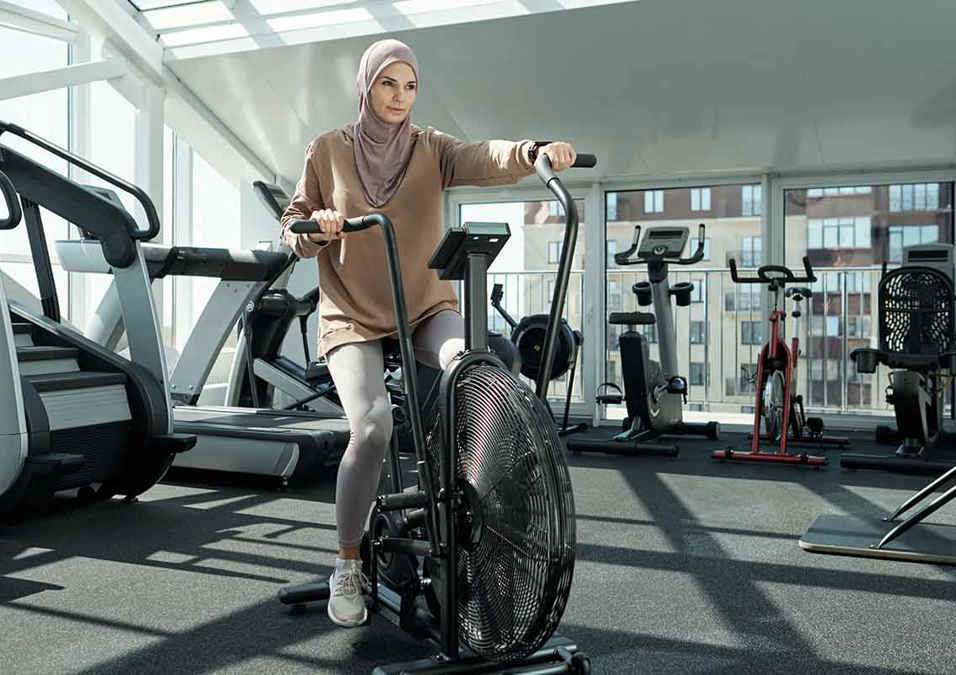The opinions shared in the GymNation blog articles are solely those of the respective authors and may not represent the perspectives of GymNation or any member of the GymNation team
Exercising During Ramadan: Your Guide to Safe Fasting and Fitness

SIGN UP FOR YOUR FREE DAY PASS TODAY!
To enhance cardiovascular health, incorporate strength training with low-intensity steady-state cardio activities such as incline walking, light cycling, or using an elliptical machine. Image Source: Shutterstock
During the holy month of Ramadan, many Muslims fast from dawn till sunset.
This can pose challenges for maintaining an exercise routine and energy levels.
However, with proper planning and guidance, it's feasible to stay active during this sacred time without compromising fitness goals.
Dr. Laure Revault d’Allonnes Bruchou, Consultant Cardiologist at Burjeel Hospital for Advanced Surgery in Dubai, shared expert advice on exercising while fasting during Ramadan.
Find out more in the article by GymNation: Exercising During Ramadan.
Balancing Exercise and Fasting
Individual experiences with fasting and exercise can vary significantly based on factors like your fitness level, the fasting method you choose, and your personal health.
Dr. Bruchou advises seeking guidance from a healthcare provider or nutritionist to customize recommendations for your unique circumstances.
For newcomers to fasting or those combining it with exercise, she suggests starting gradually and ramping up workout duration and intensity as your body adjusts.
Hydration is key, particularly during exercise, to prevent fatigue and maintain performance levels.
Age-Related Guidelines
Dr. Bruchou tailors her advice to different age groups, considering their specific needs.
For individuals in their 30s, capable of higher-intensity workouts, she recommends adding strength training to preserve muscle mass, which can decline from the early 30s. "Weight training or bodyweight exercises offer excellent choices."
Regarding those in their 40s and 50s, Dr. Bruchou stresses the importance of consulting a healthcare professional before embarking on a new exercise regimen, especially if combining exercise with fasting.
"Guidelines and experiences vary.
Adapting your routine based on personal health, fitness levels, and how you feel during fasting is crucial," she emphasized.
workout Timing in the UAE
In the UAE, where daytime temperatures soar, selecting the right time for fasting exercise is crucial to prevent dehydration and heat-related issues.
Dr. Bruchou advises considering the climate, fasting routine, and personal energy levels to pinpoint the most suitable workout time.
"Determining the ideal time for fasting exercise in the UAE involves a delicate balance of these aspects to safeguard your well-being."
So, when's the optimal time for a workout while fasting during Ramadan? Find out more in the article by GymNation: RAMADAN EXERCISE GUIDE
As per Dubai-based fitness coach Rémi Rambion, the best times are just before Iftar or an hour after a light, easily digestible meal.
This meal can include fruits, rice, potatoes, honey, and protein sources such as chicken, turkey, or a protein shake.
“Working out before Iftar allows you to eat and drink immediately after your session, which can help build or maintain your muscle mass.
It can be a bit difficult to train with low energy, but I think it’s the best option for someone who wants to conciliate fitness and family/friends,” he said.
“Exercising one hour after Iftar gives your body time to digest the first meal and be hydrated to utilise the energy for a more intense workout.”
For dedicated gym-goers concerned about potential muscle mass loss during the fasting period, Rambion recommends engaging in strength training and weight lifting at least three times a week and ensuring adequate protein intake.
He provided an example that a man weighing 80 kilograms should aim to consume around 144 grams of protein daily.
To calculate this, you need to multiply your body weight in kilograms by 1.8g (the recommended optimal protein intake per kg).
However, for those who simply wish to maintain fitness during the holy month, he suggests focusing on moderate-intensity workouts that sustain fitness levels without excessively taxing the body.
“If you’re used to strength training and weight lifting, don’t change your training.
It’s the best way to keep your muscle mass,” he said.
“Prioritise less volume – less exercise or less sets per exercise – but [with the] same intensity so you will create your training with a lot of poly-articular exercises like squats, deadlifts, pull-ups, military press, and bench press.”
In addition, incorporating strength training with low-intensity steady-state cardio, such as incline walking, light cycling, or using an elliptical machine, is an optimal approach to maintain cardiovascular health without excessively depleting energy reserves.
“I recommend avoiding High-intensity interval training (HIIT) and prolonged cardio during fasting hours.
But to avoid doesn’t mean to forbid yourself; if you want to train like this, and it makes you feel good, feel free to continue.
It’s also wise to avoid exercises that involve a high risk of injury, especially when the body’s energy levels might not be at their peak,” added Rambion.
However, individuals aged 40 and above should focus on exercises that support joint health, flexibility, and strength.
“Strength training is important and very good for people who want to build muscle and have a healthy lifestyle, but attention should be given to form and proper warm-up routines to prevent injury,” he advised, emphasising the need for closer attention to hydration and nutrition during non-fasting hours.
“The gym is not allowed only for 18-30, I love to see seniors train and understand the benefits of weight lifting for longevity.”
Source: arabianbusiness
GET YOUR FREE TRIAL TODAY

















































































